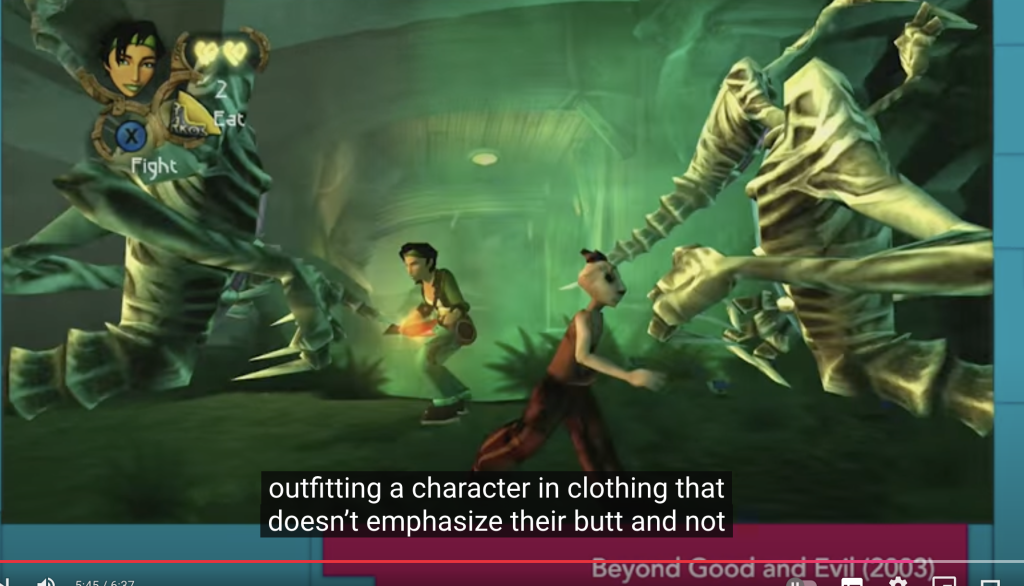SUMMARY:
This blog post will delve into the reflection of the male gaze in video games, highlighting five examples like Stellar Blade and Tomb Raider that illustrate objectification through character design and camera angles. As well as two games, Mirror’s Edge and Beyond Good and Evil, that successfully avoid it. It will also proposes actionable solutions, such as incorporating diverse creators and rethinking character portrayal, to create more inclusive and empathetic gaming experiences.
A key idea of feminist film theory, the concept of the male gaze, was introduced by scholar and filmmaker Laura Mulvey in her now-famous 1975 research, Visual Pleasure and Narrative Cinema. (The Conversation,2016). when the camera takes on the perspective of a stereotypical heterosexual man, the male gaze shows. In games, it can be as simple as the in-game camera resting so that a character’s butt or breasts or both are centerline. It can be cutscenes that rest on a woman’s butt, it can be clothing that they are wearing or the way they talk, or it can be as basic as the way a female character moves around the game world. (NYMG,2016)

The paradox of phallocentrism in all its manifestations is that it depends on the image of the castrated woman to give order and meaning to its world.
Laura Mulvey
From: https://x.com/SmashJT/status/1774629265549758616?t=7_9tjq6adu8-4fZ7pTHgtw&s=19
In video games, this concept manifests visually and narratively. For instance, Stellar Blade has been criticized for catering to the male gaze, with its protagonist, Eve, designed to be attractive to a presumed straight male audience. Eve’s body is based on scans of Korean model Shin Jae-eun, but her face was created in-house. This choice has sparked debate about objectification and the value placed on different parts of a woman’s body. During combat, she is seen as a powerful and athletic character, but cutscenes often focus on her physical appearance, which obviously shows the male gaze. ( Inverse,2024)
Similarly, in Tomb Raide, Lara Croft’s character design and camera angles often emphasize her buttocks, making her a focal point of sexualization. More like this, there’s a big difference between how Batman’s body is and Catwoman’s body shown in Batman: Arkham City. Catwoman’s character is often demonstrated in ways that emphasize her butts. Also, in Bayonetta, the protagonist’s movements and camera angles are designed to highlight her body, particularly her big buttocks, in a sexualized manner. There are many more examples like this, which miserably reflect the ‘male gaze’ trend in video games. (Kickstarter ,2016)
But on the other hand, some video games did a really good job of avoiding the male gaze. Such as the Mirror’s Edge, which shows the protagonist Faith is portrayed as a strong and capable character. With practical attire and camera angles that emphasize her athleticism rather than objectifying her. Also, in Beyond Good & Evil, the game built a depicted and well-rounded character Jade, with practical clothing and camera angles that do not objectify her. (Kickstarter, 2016)
So these games significantly show a fact: video games can be created without including the male gaze. According to WE NEED MORE STRONG FEMALE CHARACTERS IN GAME ART & DESIGN ROLES, as of 2023, around 50percent of people who play games are women.
If producers want to create video games that are only intended for male audiences, it’s really unwise because they are alienating a huge demographic
Inverse2024
Therefore, this shows if games want to attract more audiences, It’s about making games more sexy to more people (Inverse, 2024). This is indeed true, game companies could stand to expand their horizons when it comes to attraction. Rather than just catering to the male gaze and creating hourglass figures and jiggly bits, they also can consider the muscle mommies, the dad bods, and disabled people(Inverse, 2024). And why they don’t?
If they want to solve this problem, companies could use more of the inspiration and ideas of female creators, creators with disabilities, etc., or at least give them the right to create.
Moreover, the solution is not just simply to show more butts of male characters. Equal opportunity butt display is definitely not the way to solve. Rather, the method is to deemphasize the rear ends of female characters, so that players are encouraged not to ogle and objectify these women, but to identify and empathise with them as people. These really aren’t difficult tasks, when designers are creating female creators, they just need to do the same things when they’re creating the male ones. (Kickstarter, 2016)
References:
Laura Mulvey (1975), Visual Pleasure and Narrative Cinema, Screen, Volume 16, Issue 3, Autumn 1975, Pages 6–18. Available at: https://doi.org/10.1093/screen/16.3.6
The Conversation (2016). Explainer: what does the ‘male gaze’ mean, and what about a female gaze? Available at: https://theconversation.com/explainer-what-does-the-male-gaze-mean-and-what-about-a-female-gaze-52486
NYMG (2016) Video Games and the Gaze: What Does it Mean to See/Play and Be Seen/Played? Available at: https://www.nymgamer.com/?p=13435
kickstarter (2016), The Future of Tropes vs Women; An End in Sight. Available at: https://www.kickstarter.com/projects/566429325/tropes-vs-women-in-video-games/posts/1469466
Youtube (2016) Strategic Butt Coverings – Tropes vs Women in Video Games. Available at: https://youtu.be/ujTufg1GvR4
Inverse (2024) Stellar Blade and the Male Gaze, Available at: https://www.inverse.com/gaming/stellar-blade-the-male-gaze-sweet-baby
Women in games (2024), WE NEED MORE STRONG FEMALE CHARACTERS IN GAME ART & DESIGN ROLES. Available at: https://www.womeningames.org/we-need-more-strong-female-characters-in-game-art-design-roles/









